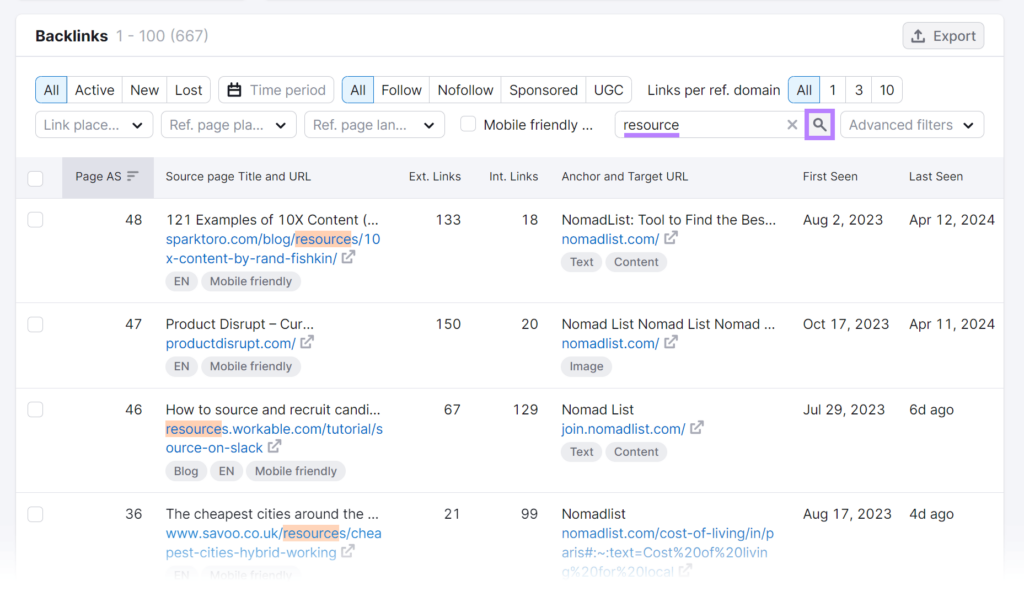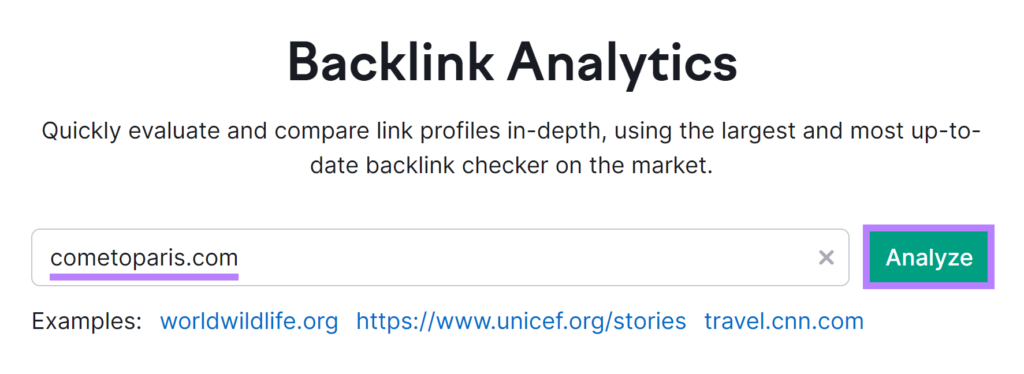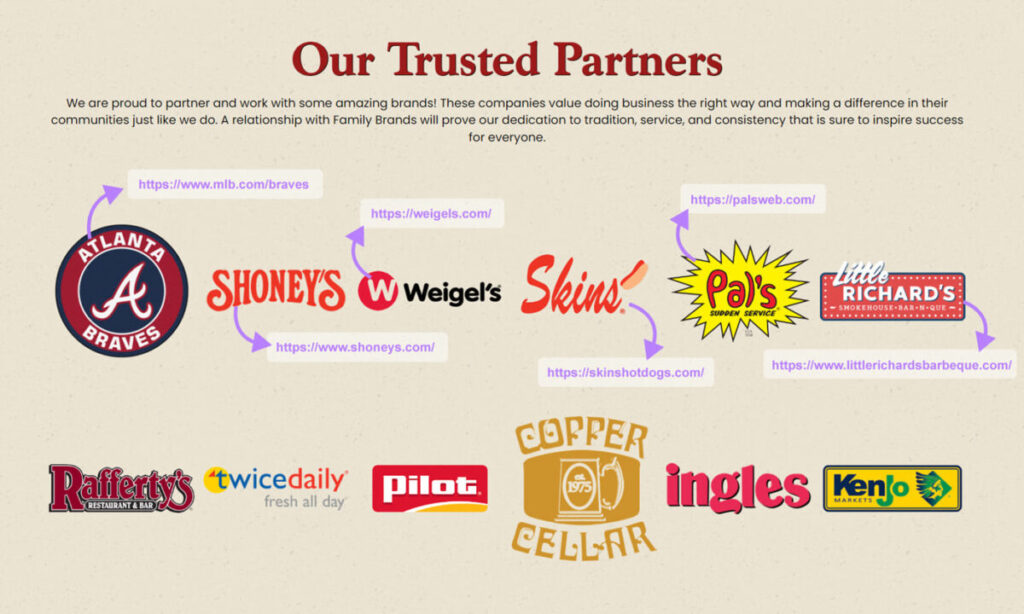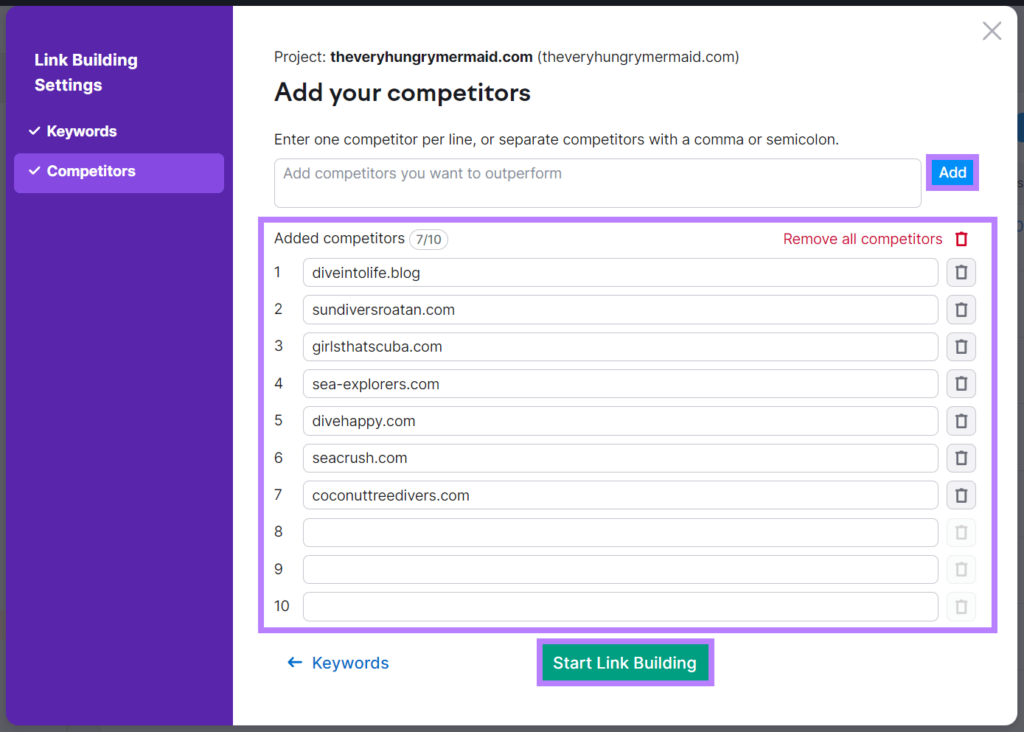Originally Posted on “Backlinks” – Google News by Siew Ann Tan
The right backlinks act as endorsements from other websites that tell search engines your site is helpful, authoritative, and trustworthy. Which can lead to improved organic (unpaid) rankings and increased traffic.
And you can secure quality backlinks with some smart tactics. Which are referred to as link building.
In this article, we’ll explore how to get backlinks with 10 effective techniques.
Let’s get started.
How to Get Backlinks: 10 Trusted Methods:
1. Get Links on Resource Pages
Resource pages list helpful content and tools for a particular industry. And if they feature you, they typically link to your site.
For example, flutist Brenna Wiinanen has a page sharing 10 resources for fellow flutists. And each heading contains a link readers can click to visit the relevant page.

Use Semrush’s Backlink Analytics to find resource pages relevant to your niche that you can get backlinks from.
It helps you identify resource pages that link to your competitors. Which means they’d likely be happy to link to your site if they find it valuable.
Type a competitor’s domain in the tool and click “Analyze.”

Select the “Backlinks” tab and scroll down to view a list of websites linking to that competitor.
To see only resource page links, type “resource” (you might also try “tools” or “blogs” depending on your niche) into the “Filter by title or URL” search box. Then, click the search button.

Note the resource pages you’d like backlinks from and contact their webmasters.
Then share your site or the specific page you’re focused on with them. And highlight how it’s valuable to their readers.
With a good pitch and a bit of luck, they might agree to update their resource page with a link to your suggested content.
2. Replace Broken Links with Links to Your Site
Broken link building is the practice of finding relevant online content containing links that don’t work. And persuading those sites to replace the broken ones with active links to your pages.
Let’s say a food-focused website added a link to a recipe on Jennifer Segal’s site—Once Upon a Chef. And that recipe was later deleted or moved to a different URL.
Now, when you click the link, you’ll see this error page:

If you run a recipe blog, you could reach out to that website. And ask them to replace the broken link with a link to a relevant recipe on your own blog.
Broken links don’t take long to replace. And everyone wins because:
- Users no longer get a frustrating error
- Webmasters can maintain a good user experience
- You’ll receive a new backlink
Discover broken links you can replace with Semrush’s Backlink Analytics.
Enter one of your competitor’s domains and click “Analyze.”

Click the “Indexed Pages” tab. And check the box next to “Broken Pages” to view that website’s broken pages.
Look for broken pages about topics you also cover on your site.
For instance, if you have a post about picking the best light bulbs, it could be a good substitute for this article from Lifehacker:

The number in the “Backlinks” column tells you how many backlinks that page has. Click it to view all relevant backlinks and their source pages.

Next, click the “Page AS” column to sort the source pages by Authority Score. This is a proprietary Semrush metric that evaluates a page’s quality—the higher the score, the better.
And compile a list of websites you want to reach out to.
Contact the webmasters at these websites to Inform them about the broken link. And suggest they replace it with a link to your page.
Your request should also contain information on the broken link in question—like its anchor text and the page URL. Backlink Analytics makes this data readily available.

Provide these details to webmasters so they can locate the broken link more easily. And (hopefully) quickly replace it with a link to your page.
3. Create Skyscraper Content
Skyscraper content refers to any piece that’s the best resource on a topic because it’s comprehensive, original, and visually appealing. Ane creating this type of content makes it easy to convince websites to swap an existing link with yours instead.
Think of it this way:
Your content becomes a skyscraper towering over your competitors’ low-rise buildings. So their pieces won’t stand out compared to yours.

Since skyscraper content takes a long time to create, focus on topics that other websites are already getting many backlinks for. Because you’ll be more likely to get backlinks if the topics you cover are already popular.
Find suitable skyscraper content topics for your brand with Semrush’s Backlink Analytics.
Open the tool, enter a competitor’s domain, and click “Analyze.”

Head to the “Indexed Pages” tab for a list of that domain’s indexed pages. Plus the number of backlinks to each page.
Then, find pages with a lot of backlinks that you think you could cover better.

In this case, you decide to start creating skyscraper content about beautiful places in Paris. But yours will be longer, feature original photography, and include insights from locals.
Once your piece has been published, click the number in the “Backlinks” column that corresponds to the competing page.
You’ll then see all the domains that link to the competing page.

Choose the sites you want to approach for a backlink. Then, reach out to their webmasters to:
- Mention you saw the website’s link to the competing content
- Share the link to your skyscraper content on the same topic
- Explain what makes your content better or more comprehensive
- Suggest that the website link to your content instead
4. Perform a Backlink Gap Analysis
A backlink gap analysis lets you find websites that link to your competitors’s sites but not yours. To identify any “gaps” you should address.
Semrush’s Backlink Gap tool can help you do this.
Open the tool, enter your domain in the first field and add at least one competitor’s domain (you can add up to four competitors). And click “Find prospects.”

You’ll get a list of websites linking to your competitor(s). But not to you.

The numbers in a competing domain’s column show the total number of backlinks they got from each website in the list.
Click any number to check which pages on the referring domain link to your competitor(s).

When you discover websites you want to get links from, tick the checkboxes next to them and click “Start outreach.”

The window that appears next lets you send the selected websites over to Semrush’s Link Building Tool.

You can email prospects directly from this tool without having to switch to your inbox. So you’re able to manage your link-building outreach efforts in one place.
5. Create Linkable Assets
Linkable assets are highly valuable pieces of content that naturally attract backlinks. And creating and promoting them is one of the most effective link-building tactics for SEO.
These assets may include:
- Comprehensive guides
- Research studies and surveys
- Infographics
- Free tools (calculators, trackers, converters, etc.)
Linkable assets tend to attract follow backlinks. Which indicate to search engines that the linked piece is reputable and deserving of being ranked on search engine results pages (SERPs).
For example, Semrush’s 2023 State of Content Marketing is a comprehensive report covering data on top content marketing trends, content marketing industry practices, content performance, and more.

According to Backlink Analytics, it has about 3,600 backlinks from 805 referring domains (as of May 2024). And 88% of them are follow backlinks (i.e., links that generally pass authority).

After creating linkable assets, you’ll want websites to voluntarily link to them without you requesting it. But you’ll still need to promote those assets in some way to help others discover and link to them.
To do this, you can:
- Use SEO best practices to increase organic traffic
- Share the linkable assets on your social media platforms
- Run paid ads to quickly drive qualified traffic to your linkable assets
6. Provide Testimonials
Providing testimonials about the products or services businesses in your niche offer can help you gain valuable backlinks.
Let’s say you write a review for a service you’ve enjoyed and the brand agrees to publish your contribution on their website. They may also add a backlink to your site when attributing the testimonial to you.
Just like how business coach Emma McQueen links to clients’ sites from the featured testimonials:

This method works especially well if you’re on good terms with the brand already. And can directly ask for a link.
Even if you don’t know anyone from the target business, create the testimonial anyway and publish it on your site. Then, send a message to let them know.
The business may promote your testimonial on their website. And even link to it.
That’s what Pedaling Innovations did when they got a good review from Pinbike.

7. Gain Links from Partners and Suppliers
Leveraging existing business relationships with partners and suppliers can be a great way to get backlinks. Because they’re likely more than happy to provide a link.
Here are some ideas for using this technique:
- Write guest posts for your partners’ websites. These posts should credit you as the author and contain a link to your site.
- Provide testimonials for your partners’ products or services. And request that they publish these testimonials with a backlink.
- Ask your partners to include you on their partner page. And ask that they include a link back to you on that page.
For instance, check out this partner page from Family Brands.

Each partner logo is a clickable link leading to the respective partner’s website. So all these partners have backlinks from Family Brands.
What if you don’t have any partnerships like this yet?
Use Semrush’s Link Building Tool to identify prospects to build relationships with—and seek backlinks from when the time is right.
Enter your domain name and click “Start Link Building.”

Enter your domain again and give your link-building project an optional name. And hit the “Create project” button when you’re ready.

Enter up to 10 keywords you want higher search rankings for, select your target country, and add up to 10 competing domains you want to outrank.
Then, click “Start Link Building.”

When the tool has finished running, click “View prospects.”
The “Prospects” page will load with a list of suggested websites to get backlinks from.

Backlinks from websites with a 4/5 or 5/5 rating in the “Rating” column may be especially valuable. So, consider contacting them about forming a relationship first.
Tick the checkboxes for your target websites. Then, click the “To In Progress” button at the top of the list to add the websites to your prospects list.

Click the “In Progress” tab to view your chosen prospects.

From here, start a conversation using the contact information the tool provides.
Just make sure you’ve spent time putting together an actual partnership proposal. Like providing a 10% discount to mutual customers. Or agreeing to both contribute one blog post to the other site each month.
Once you’re on friendly terms, raise the idea of having them link to your website.
8. Respond to Quote Requests
Use websites like Connectively to respond to journalists’ and bloggers’ requests for expert quotes. Because these writers may link to your website when attributing the quote to you.
Here’s how psychologist and author Harriet Lerner got a backlink to her website when TODAY.com quoted her in an article:

To use Connectively, go to their site and click “Join Now” to create an account.

Go through the account creation process. And select “I’m a Subject Matter Expert” on the “Tell us who you are” screen.

Once you’ve successfully been onboarded, you’ll see a “HARO Queries” table with writers’ requests for quotes.

Now, you can click any request to view more information about it (the publication, response deadline, etc.) and submit a pitch if you think you’re a good fit.
If the writer includes your quote in their article, they may link to your website when crediting you.
There are also other digital PR websites that help connect writers with subject matter experts. Like Help a B2B Writer and SourceBottle.
You may even be able to form relationships with journalists. So you can reach out to them directly in the future.
9. Identify Unlinked Mentions
Unlinked mentions are when websites talk about your brand without providing a link to your website. And they can easily turn into backlinks if you know where they are.
For instance, the game company Exploding Kittens could reach out to Mythical Meeples about updating their brand mentions to include links.

How do you find unlinked mentions?
With the Brand Monitoring app from Semrush’s App Center. Which alerts you of new unlinked brand mentions. So you can reach out to request backlinks.
Sign up for the tool and click the “Get started” button once you have access.

Then, select “Brand.”

A “Create brand query” window will appear.
Follow the prompts to configure the tool. Then, click “Create query.”

The tool will list your brand mentions over the past 30 days and from now on.
Click “Mention details” and select the circle next to “Without backlinks” to view only your unlinked mentions.

Click any unlinked mention on the right to view it on the original page.
You can then contact the webmaster and ask them to turn the unlinked mention into a backlink.
To get email alerts of new unlinked mentions, click the “Email notifications” tab at the top. Then, hit the “Set up email notifications” button.

Select your preferred alert frequency (daily, weekly, when you get a new mention, when there’s an unusual spike, etc.). And provide any other necessary details.
To be alerted about unlinked mentions, go to “More filters” > “Add filter” > “Article backlinks” and select the circle next to “Without backlinks.” And click “Save.”

Finally, click “Save” at the bottom of the window.
Now, you’ll get regular email alerts about your brand’s unlinked mentions.
10. Reclaim Lost Links
Getting new sites to link to you isn’t the only way to improve your backlinks profile. You can also do it by recouping backlinks you’ve lost over time.
Monitor your website’s backlink profile using Semrush’s Backlink Audit. So you’ll know if you’ve lost any backlinks and can reach out to have them reinstated.
Enter your website’s domain and an optional project name. Then, click “Create project.”

Select the scope of your audit and follow Semrush’s Backlink Audit configuration steps to customize your settings.
After that, click “Start Backlink Audit” to run the tool.

When the backlink audit is complete, click the “Lost & Found” tab.

Scroll down the “Lost & Found” table and click the “Lost” tab to see which domains you lost backlinks from in the last three months. As well as the intended pages on your site and the date you lost the backlinks.

Consider prioritizing lost backlinks from websites with higher Authority Scores. Because backlinks from these websites have a higher potential to improve your site’s rankings.
Then, contact webmasters. Ask why they’ve removed the link and work with them to restore it—if possible.
For example, a webmaster may have removed a link because it points to outdated information.
If so, provide them with a link to the latest content on your site. They may be happy to add a link to the new resource.
Expand Your Website’s Link Ecosystem
Understanding how to acquire backlinks is the key first step to raising your website’s backlink profile.
We’ve shared 10 methods here, but you don’t have to use them all.
Focus on the ones that work best for you. And invest in the right tools like Semrush’s Backlink Analytics to aid your efforts..
Try this and other tools for free by signing up for a Semrush account.
About the Author
Siew Ann draws on her five years of SEO and email marketing experience to write creative, well-researched content for B2B SaaS businesses. Her articles have ranked on the first page of Google and as high as #1.






